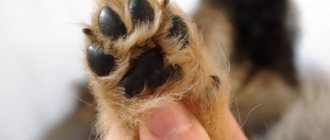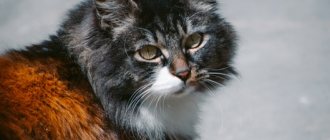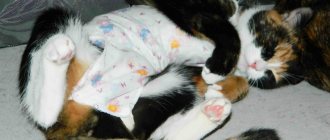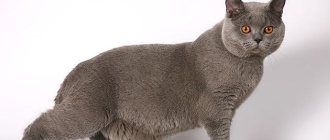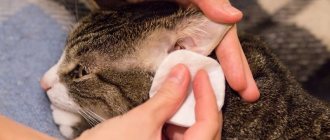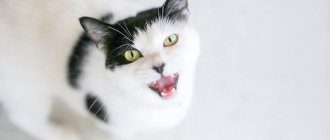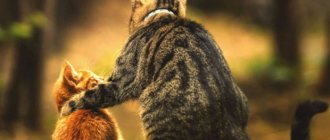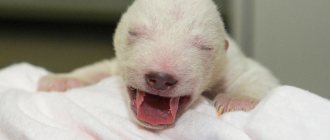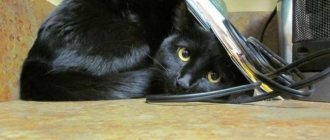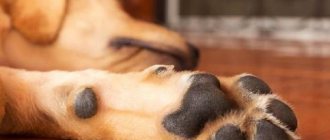It would seem that everyone knows how many fingers a person should have. And even a baby knows that there are five fingers on both hands and both feet. But this is only normal, because in nature there are also such anatomical deviations as polydactyly (when there are more fingers on one or more limbs than normal, for example, 7 instead of the usual 5) and ectrodactyly (when there are less than 5 fingers on the hand or foot, for example, only 3). Well, the number of fingers on human limbs is now clear. How many fingers does a cat have?
Different number of fingers
Normally, a cat should have five toes on its front paws and four on its back paws. But it happens that there are six or even more of them. This is already a deviation from the norm called polydactyly. This is a genetic mutation, but it seems to help cats. They use extra fingers to improve dexterity. But normally, a cat has 5 fingers in front, 4 of which have pads, and one is located slightly to the side and does not have a pad.
Bobo, ruffles, patchwork: trendy denim items this spring that suit everyone
72 years overdue: Theodore Roosevelt's biography returned to the library
Fertilizer for growth: scientists tell how you can use coffee grounds
Positive and negative properties of polydactyly
Every responsible owner of such special pets is in a hurry to find out why such an anomaly as polydactyly is dangerous and what consequences are inherent in it. However, in most cases, extra fingers do not interfere, and even help pets:
- walking comfortably in the snow;
- it is better to climb trees and other hills;
- catch mice even more successfully;
- get down from high objects and jump.
Cat with polydactyly
It is also impossible to ignore the fact that animals with polydactyly look even cuter than ordinary ones.
Note! Despite this, there are cases where extra toes cause pain and harm to pets. Due to improper formation of the fingers, cases have been recorded where the claws grow directly into the soft flesh and paws.
Cats sweat through their paws
People often have sweaty palms during times of stress or just ordinary excitement. But few people know that purrs are also distinguished by their sweaty paw pads. They only sweat through them; this is the only place where they have sweat glands. This is how cats protect themselves from overheating and generally regulate their temperature. The paws should be clean and not covered with any socks or slippers (some owners like to dress their pets in them).
Consequences of deviations
With such a deviation, the fingers may grow too long, and because of this, the animal is not able to move calmly, as it constantly injures them. That is why, if an animal has such complications, the extra toes must be removed through surgery at an early age or consult a specialist for advice on this matter. However, in most cases, such an anomaly does not cause discomfort to cats, does not cause complications, and the animals grow up absolutely healthy and do not need treatment at all.
The consequences of the anomaly can be quite serious
Cats walk on tiptoes
Although we think of cats' paws as feet, they are more like human toes. In all cats, the feet are located higher - under the bend of the leg. Take a closer look and you will understand everything. Cats have evolved over many millennia to learn to walk this way. This gave them an advantage in helping them survive. On tiptoe they walk much quieter and faster, which is why they have no equal in hunting and running when it comes to attacking someone dangerous.
Symptoms of the disease
The chronic form of the disease is characterized by a long latent period. When more than 70% of the cellular composition of the kidneys is damaged, the following symptoms of the disease begin to appear:
- loss of appetite;
- weight loss;
- urinary disturbance;
- change in urine color;
- thirst or refusal of fluids;
- drowsiness;
- inactivity;
- diarrhea;
- vomit;
- anemia;
- smell of acetone from the mouth;
- dehydration;
- visual impairment.
A severe form of the disease is accompanied by the development of epileptic seizures, convulsions, increased body temperature and blood pressure, which leads to rupture of the blood vessels of the eyeballs and loss of vision. The cat's condition is deteriorating rapidly due to intoxication and kidney failure. The animal subsequently falls into a coma and dies.
Surgical treatment
In case of complicated fractures (for example, splinter and depressed fractures), urgent assistance from a veterinary surgeon is required. He operates on the animal to connect the bone fragments and fix them securely. After fusion of the bone tissue, all material used for connection (threads, pins) is removed. Among the main methods of osteosynthesis: • Intramedullary. The bone fragments are connected using a reliable fixation rod, which is inserted into the intramedullary canal. This technique is successfully used in more than 35% of fracture presentations; • Extramedullary (lamellar). Plates are placed over the damaged bone and then secured with screws. The main advantage of the method is strong fixation. It is usually used for comminuted as well as oblique fractures; • Extrafocal. External fixation is used using pins: they are fixed above and below the fracture. Its advantage is minimal trauma and the possibility of physical activity, which reduces the likelihood of muscle atrophy. The choice of surgical intervention method depends on the condition of the pet and the nature of the leg fracture. Please note that recovery after surgery takes 5 to 7 weeks.
Indications for use
The medicinal properties of cat's claw include:
- Detoxifying effects. The drug helps cleanse cells, improves liver function, helps cope with poisoning of various etiologies (alcohol, medication, poisoning by chemical emissions, etc.), and also removes excess fluid from the body.
- Immunomodulatory effects. The plant strengthens and heals the human immune system, increasing resistance to colds and infections.
- Recovery after a course of chemotherapy and radiation therapy. The drug gently and carefully restores impaired body functions, since radiation and chemotherapy are a difficult test for internal systems and organs.
- Anti-inflammatory effect. The drug helps relieve or reduce inflammatory processes in joints and internal organs.
- Antitumor effect. Cat's claw slows down the development of cancer.
- Acceleration of the healing process of ulcers. The drug promotes mild scarring of ulcers in the stomach and duodenum.
- Cardioprotective effects. The drug prevents the formation of blood clots and cholesterol “plaques” inside blood vessels, therefore it is used as a prevention of atherosclerosis. At the same time, the drug normalizes blood pressure, which is especially important for hypertensive patients.
- Antiparasitic effect. The drug has a detrimental effect on both adult parasites and their larvae.
A little history
Cats with such an unusual paw structure have always been found. English settlers brought the first individuals to the United States and a small population of them currently lives in Boston.
Sailors, while sailing, always took a “cat in mittens” with them. It was believed that extra fingers helped animals to be stable on the deck and better catch mice. An increased number of polydactyl cats has always been observed in port cities. Traveling to all directions of the world on ships contributed to the spread of unusual animals throughout the world.
How many fingers does a British cat have? British Shorthair: Questions and Answers
Sofia Krasnoselskaya, WCF expert on all breeds of the international category, head of the Sweet Way British Shorthair cattery, answers your questions.
Dear cat owners and kitten buyers! It is important:
- A kitten up to 2-2.5 months should not leave its mother’s house! Buy a kitten from a clean home, with deworming done (that is, when the kitten was given an anthelmintic drug), with vaccinations and documents (veterinary passport and birth certificate or pedigree from the club). Only in this case can you be relatively calm about the health of your pet. The normal age for buying a kitten is 2.5 months or more.
- Before asking your question, look for a similar question and its answer in previous posts.
- All questions about the health of your pets should be directed to the vet. section Remember that sometimes it is very difficult to give an answer about diagnosis and treatment in absentia.
Experts may not answer your questions: - about the health of the kitten, if you took it from its mother prematurely, unvaccinated and without documents; - about how to feed the kitten, how much it should weigh and other questions to which answers have been given repeatedly.
Russian folk game "Cat and Mice"
The mice dance in circles. (Children, holding hands, walk in a circle around the cat.)
The cat is dozing on the bed.
Hush, mice, don't make noise! (They shake their fingers at each other)
Don't wake up Vaska the cat.
How Vaska the cat wakes up - (Stretch their arms forward, palms up)
It will break up the whole round dance. (Alternately raise and lower your arms bent at the elbows, fingers clenched into fists)
The cat moved its ears - and the whole round dance disappeared!
(Run to their seats)
Oh, I ran too much, I’m tired!
Sit down, little cat, relax, and our kids will tell you nursery rhymes about cats.
(Children tell 2-3 nursery rhymes about cats)
Wonderful poems, thanks kids! It's time for me to go home, my kids - little kittens - are waiting for me.
Tell us, little cat, about your kittens.
One - the kitten is the whitest, Two - the kitten is the bravest, Three - the kitten is the smartest, but he is the noisiest.
And the kittens' names are Chernysh, noisy Ryzhik and Belysh. But, unfortunately, I don’t have photos of kittens and I won’t be able to show them to you.
If you want, kitty, the guys will make portraits of your kittens.
Moore! Moore!
Didactic game “Let’s put the kitten together”
Here are the details of different colors, shapes and sizes. You need to choose the right ones and make portraits of the kittens.
Let's remember what the kittens' names are? (Children: Belysh, Chernysh, Ryzhik!)
Why do you think they were called that: Belysh, Chernysh, Ryzhik?
(Children: Because Belysh is a white kitten. Blackie is black. Ryzhik is red.)
Choose a friend and agree on which kitten you will take a portrait of.
(Children are divided into three teams, the teacher finds out which kitten each team will make)
Look, little cat, how the portraits turned out.
How similar they are to my kittens. Thank you, kids, how wonderful and smart you are!
Well, I'll run home!
Wait, kitty, we’ll get your kittens some treats.
Didactic game “Who eats what”
(Various items are laid out on the table. You need to choose the right thing for what the cat eats)
Guys, look how many products are prepared. What can we treat the cat to? (Children: milk, sour cream, meat, fish, sausage.)
Come out, let's put some treats in the basket.
Meow! Thank you! The basket is so heavy, how can I get home faster?
Kitty, where do you live?
Over there in that house behind the stream. (There is a “stream” of two ropes on the floor)
Shall we help the cat? (Children: yes!)
Here are two paths - yellow and green. Which path is better for a cat to take to get home faster? (Children: Along the yellow path, because it is shorter than the green one.) (Everyone walks along the yellow path)
And then a stream. Does your cat like water? (Children: The cat does not like to bathe; she washes herself with her tongue.)
Look, is the stream the same everywhere? (Children: No, here it is wide, but here it is narrow!)
Where will it be easier for a cat to jump over a stream? (Children: It’s easier to jump over where the stream is narrow.)
What if I end up getting my paws wet?
Look what's here? (“Pebbles” are cut out of cardboard) (Children: Pebbles!)
How many pebbles? (Children: A lot!)
Let's throw pebbles into the stream and use them to cross to the other side of the stream.
And here is my house!
Goodbye kitty!
(The teacher removes the cat and the basket behind the house. The children return to their places. The teacher finds the box).
Someone brought us a package!
Let's see what we have here?
Letter from a cat!
(The teacher reads the letter)
Dear guys! I am very glad that I visited you. Now I have many friends. I became friends with you and your pets, about whom you spoke so well. You are all wonderful and kind, you love animals and do not offend them. It's fun to play with you. Thank you for the portraits and the treats you packed for my kitten babies. I will be happy to come and visit you again! In the bag there is a treat for you from me and my kittens. We also know what kids love! (The teacher hands out treats from the cat).
Signs that indicate the onset of labor
1–3 days before the onset of labor, you can understand from the cat’s behavior that this moment will soon come:
- The future tailed mother is actively looking for secluded places, every now and then trying to hide in the closet or behind the sofa. Digs there, trying to build a nest. The pet becomes very affectionate, constantly demands attention, and can sometimes be annoying. It rarely happens that a cat, on the contrary, becomes overly aggressive and hides from its owners. Other symptoms:
- at this time, the loop increases greatly, and clear or light pink discharge is observed;
- the cat begins to lick itself more often;
- There is a loss of appetite up to complete refusal of food.
- When there are a day or a little less left before lambing, the animal’s body temperature drops to 37°C.
- 4–8 hours before lambing, the animal begins to hunch over. This is how the body reacts to training contractions of the uterus. This process causes great anxiety in the pet; she may complain to the owner, seeking his support. But another option is also possible - she will try to hide.
- 4 hours before labor, the mucus plug comes off. It is a small transparent clot, sometimes it can have a yellowish or greenish tint and include small inclusions of brown, which is considered normal. Often the plug comes out during urination or in parts. But this moment may not be noticed in an overly clean animal.
- When the temperature rises to normal—38–39°C—this means that there are about 2 hours left before birth.
Call a veterinarian immediately if:
- a furry pet carries kittens longer than expected;
- the pet experiences fever, vomiting and convulsions;
- bleeding lasts more than 10 minutes and is accompanied by an unpleasant odor.
Premature birth
Sexual infections, physical trauma, and severe stress are some of the main causes of premature lambing. This problem can occur in older cats or in representatives of breeding and selective breeds who are giving birth for the first time.
Be sure to show your pregnant cat to a veterinarian, and before giving birth, agree with him about help if necessary.
If lambing occurs when the gestation period is 51 days or more, the kittens are considered viable and must be fought for their lives. Call your veterinarian immediately. But under no circumstances try to stop contractions in order to postpone labor until a specialist arrives. You will have to deliver the baby yourself.
How to behave with a pet
If this is your first time attending the birth of a family pet, then excitement is a natural process. You must understand that when a furry mother goes into labor, she experiences pain, fear and needs support. Your behavior will largely determine the successful outcome of the case. Even if you don’t really understand how to act, control yourself. Get together and provide all possible assistance:
- Try to ensure that no strangers or curious people gather near the lambing area.
- Apart from the owner, there should be no other people in the cat's field of vision, even if they are family members to whom the cat is accustomed.
- Talk kindly to your pet, show her that you are nearby and will not abandon her in difficult times. Stroke it from top to bottom. Speak kind words.
Your participation will calm the cat before giving birth
What time can an animal have its claws removed?
Cat claws are an integral part of a natural lifestyle. They are needed for successful hunting, tree climbing, and self-defense. Unfortunately, some owners prefer cleanliness, order, intact furniture and wallpaper, so they turn to veterinarians with a request to remove the claws of their pet. This operation is called onychectomy. This very complex surgical procedure involves amputating the cat's phalanx of toes and claws.
In Russia, nail removal is called “Soft Paws”. However, the attitude of both veterinarians and most cat lovers towards the operation is negative. Having deprived their cat of protection, people are sometimes unaware of the unpredictable consequences for their pets. In some EU countries, onychectomy is prohibited by law, and a veterinarian who decides to perform such a risky operation may lose his license. This procedure is permitted only if there are special indications:
- If the cat's behavior is so aggressive that it causes injury to people or other pets.
- If there are physiological reasons related to your pet’s health.
The complexity of the operation and the severity of possible consequences are so great that only young and healthy cats can undergo onychectomy. Even with a quick and successful postoperative period, the future life of the furry will be disrupted. Removal of the phalanges of the fingers with claws leads to a reduction in the size of the paw and redistribution of the load on the musculoskeletal system. As a result, arthritis, joint displacement, and dysfunction of the vestibular apparatus will haunt the cat for the rest of its life.
How to prevent pathologies and maintain health?
Caring owners know that the best solution is to carry out preventive measures on an ongoing basis. They include performing the following rituals:
- daily visual inspection of the paws for damage and inflammation
- routine visits to the veterinary clinic
- treating paws with antiseptics to prevent fungi and bacteria from entering the tissues
With timely initiation of treatment, which involves antibiotic therapy, the animal’s condition can be alleviated and, over time, the furry pet’s lost quality of life can be completely restored.
Massage
Breeders sometimes underestimate the importance of massaging their cat's paws. Regular massage prevents the deposition of salts in the joints, improves blood circulation and makes it easier for the cat to endure the nail trimming procedure.
Massaging a cat's paws is very simple; it is enough to give it 2 times a week.
Start with trusting contact with the animal. To do this, hold each paw in your hands for 3 seconds. Do this gently, and if the cat removes its paw, gently return it back.
To keep your cat's paws healthy, they need to be massaged regularly.
Then rub the top of your paw a little. Gently apply pressure on your fingers so that the cat releases its claws. This will prepare her for nail trimming. Light strokes and pressure are enough to keep your cat's paws healthy.
